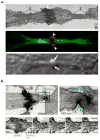Resurrecting remnants: the lives of post-mitotic midbodies
- PMID: 23245592
- PMCID: PMC4196272
- DOI: 10.1016/j.tcb.2012.10.012
Resurrecting remnants: the lives of post-mitotic midbodies
Abstract
Around a century ago, the midbody (MB) was described as a structural assembly within the intercellular bridge during cytokinesis that served to connect the two future daughter cells. The MB has become the focus of intense investigation through the identification of a growing number of diverse cellular and molecular pathways that localize to the MB and contribute to its cytokinetic functions, ranging from selective vesicle trafficking and regulated microtubule (MT), actin, and endosomal sorting complex required for transport (ESCRT) filament assembly and disassembly to post-translational modification, such as ubiquitination. More recent studies have revealed new and unexpected functions of MBs in post-mitotic cells. In this review, we provide a historical perspective, discuss exciting new roles for MBs beyond their cytokinetic function, and speculate on their potential contributions to pluripotency.
Copyright © 2012 Elsevier Ltd. All rights reserved.
Figures


Similar articles
-
Actin, microtubule, septin and ESCRT filament remodeling during late steps of cytokinesis.Curr Opin Cell Biol. 2018 Feb;50:27-34. doi: 10.1016/j.ceb.2018.01.007. Epub 2018 Feb 10. Curr Opin Cell Biol. 2018. PMID: 29438904 Review.
-
Cytokinetic abscission requires actin-dependent microtubule severing.Nat Commun. 2024 Mar 2;15(1):1949. doi: 10.1038/s41467-024-46062-9. Nat Commun. 2024. PMID: 38431632 Free PMC article.
-
The role of midbody-associated mRNAs in regulating abscission.J Cell Biol. 2023 Dec 4;222(12):e202306123. doi: 10.1083/jcb.202306123. Epub 2023 Nov 3. J Cell Biol. 2023. PMID: 37922419 Free PMC article.
-
Midbody assembly and its regulation during cytokinesis.Mol Biol Cell. 2012 Mar;23(6):1024-34. doi: 10.1091/mbc.E11-08-0721. Epub 2012 Jan 25. Mol Biol Cell. 2012. PMID: 22278743 Free PMC article.
-
Plant ESCRT Complexes: Moving Beyond Endosomal Sorting.Trends Plant Sci. 2017 Nov;22(11):986-998. doi: 10.1016/j.tplants.2017.08.003. Epub 2017 Aug 31. Trends Plant Sci. 2017. PMID: 28867368 Review.
Cited by
-
Midbody: From the Regulator of Cytokinesis to Postmitotic Signaling Organelle.Medicina (Kaunas). 2018 Jul 30;54(4):53. doi: 10.3390/medicina54040053. Medicina (Kaunas). 2018. PMID: 30344284 Free PMC article. Review.
-
A Model for Primary Cilium Biogenesis by Polarized Epithelial Cells: Role of the Midbody Remnant and Associated Specialized Membranes.Front Cell Dev Biol. 2021 Jan 7;8:622918. doi: 10.3389/fcell.2020.622918. eCollection 2020. Front Cell Dev Biol. 2021. PMID: 33585461 Free PMC article. Review.
-
Endocytic transport and cytokinesis: from regulation of the cytoskeleton to midbody inheritance.Trends Cell Biol. 2013 Jul;23(7):319-27. doi: 10.1016/j.tcb.2013.02.003. Epub 2013 Mar 20. Trends Cell Biol. 2013. PMID: 23522622 Free PMC article. Review.
-
Core binding factor β (CBFβ) is retained in the midbody during cytokinesis.J Cell Physiol. 2014 Oct;229(10):1466-74. doi: 10.1002/jcp.24588. J Cell Physiol. 2014. PMID: 24648201 Free PMC article.
-
PRL-3 disrupts epithelial architecture by altering the post-mitotic midbody position.J Cell Sci. 2016 Nov 1;129(21):4130-4142. doi: 10.1242/jcs.190215. Epub 2016 Sep 21. J Cell Sci. 2016. PMID: 27656108 Free PMC article.
References
-
- Guizetti J, Gerlich DW. Cytokinetic abscission in animal cells. Semin Cell Dev Biol. 21:909–916. - PubMed
-
- Barr FA, Gruneberg U. Cytokinesis: placing and making the final cut. Cell. 2007;131:847–860. - PubMed
-
- Gromley A, et al. Centriolin anchoring of exocyst and SNARE complexes at the midbody is required for secretory-vesicle-mediated abscission. Cell. 2005;123:75–87. - PubMed
-
- Caballe A, Martin-Serrano J. ESCRT machinery and cytokinesis: the road to daughter cell separation. Traffic. 12:1318–1326. - PubMed
Publication types
MeSH terms
Substances
Grants and funding
LinkOut - more resources
Full Text Sources
Other Literature Sources
Miscellaneous

